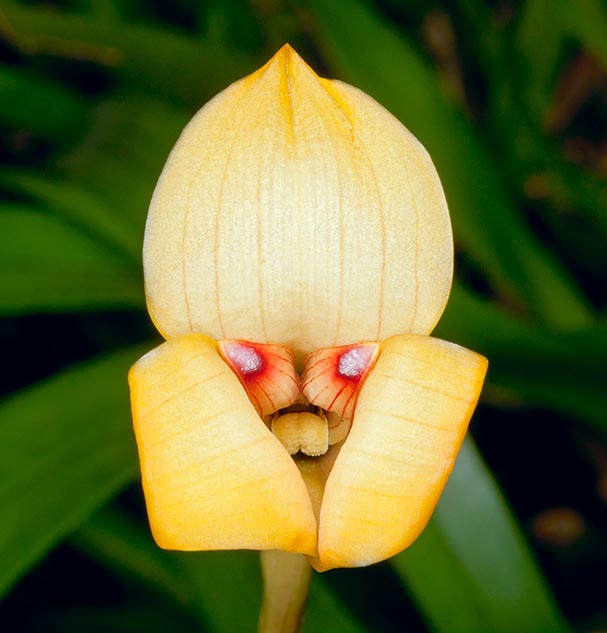Family : Orchidaceae

Text © Pietro Puccio

English translation by Mario Beltramini

Trigodinium egertonianum is an epiphyte or lithophyte with odd flowers and easy to cultivate © G. Mazza
The name of the genus comes from the Greek “trigonos” = triangle, with reference to the disposition of the sepals and to the shape of other parts of the flower; the species is honoured to the English palaeontologist and politician Philip de Malpas Grey Egerton (1806-1881).
Common names: dragons mouth orchid, Egerton’s Trigodinium (English).
The Trigonidium egertonianum Bateman ex Lindl. (1838) is an epiphytic or lithophytic species with tight ovoid pseudobulbs, compressed and grooved, 4-8 cm long and 2-3 cm thick, with at the apex two ensiform leaves 20-60 cm long and 1-3 cm broad; in the wild it may loose all the leaves in occasion of particulary dry and prolonged seasons.
Single or numerous inflorescences from the base of the pseudobulb, 15-35 cm long, erect, carrying only one flower, on an about 5 cm long peduncle, with greenish yellow sepals and petals with from purple to brown venations and greenish labellum; the flower lasts about two weeks. Ovate-lanceolate sepals, 1,5-3 cm long and 1-2 cm broad, erect dorsal, the two lateral ones with retroflexed apices, linear-lanceolate petals, 1-1,5 cm long and about 0,6 cm broad, with a grey-bluish and glossy thickening close to the apex, trilobed labellum, about 0,8 cm long and 0,4 cm broad, semi-elliptic lateral lobes and linear median one, rather callous, warty and bent at the apex.
It reproduces by seed, in vitro, and by division, with each section provided with at least 3-4 pseudobulbs.
Floriferous and easy to cultivate species with tiny flowers, but having quite a particular look, it requires medium-high temperatures with winter lowest values not less than 15 °C, even if it can bear sporadic, and for a very short time, drops of some degrees if completely dry, a semi-shaded position, also with some hours of direct sun, and high, constant humidity, 60-80%.
During the growing time, the waterings must be regular, but allowing to slightly dry up before giving water again, more spaced during the vegetative stasis, allowing the substratum to dry up completely; good ventilation is necessary for avoiding water stagnations at the base of the pseudobulbs and between the leaves, after the waterings, which would cause easy rottenness. For the waterings and the nebulisations rain water is to be utilized, or water obtained by reverse osmosis or demineralised; the fertilizations, duly distributed and alternated, in way to avoid salts accumulation at the roots, are to be done during the vegetative period preferably with hydro-soluble balanced products, with microelements, at half dosage than what suggested on the package. It can be mounted on trunks, bark, cork raft or cultivated in pot with a very draining and aerated compost, which may be formed by medium sliced bark fragments with possible addition of inerts in order to improve the drainage.
The species is reported in the appendix II of the CITES (species whose trade is internationally ruled).
Synonyms: Maxillaria brachyglossa A.Rich. & Galeotti (1845); Trigonidium seemannii Rchb.f. (1854); Trigonidium spatulatum Linden & Rchb.f. (1854); Trigonidium callistele Rchb.f. (1860); Trigonidium brachyglossum (A.Rich. & Galeotti) Schltr. (1918).
→ For general notions about ORCHIDACEAE please click here.
